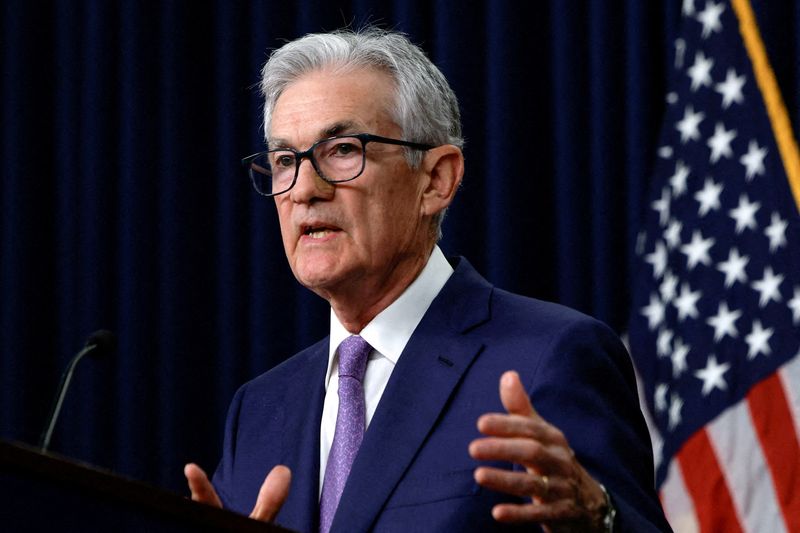By Howard Schneider
JACKSON HOLE, Wyoming (Reuters) – Federal Reserve Chair Jerome Powell made it clear on Friday the U.S. central financial institution wouldn’t shrink back from pivoting to rate of interest cuts within the ultimate weeks of a presidential election marketing campaign and that defending the job market was now its prime precedence.
“The time has come for policy to adjust,” Powell stated in a speech to the Kansas Metropolis Fed’s annual Jackson Gap convention in a powerful sign the central financial institution will begin slicing charges in mid-September, roughly seven weeks earlier than the Nov. 5 election.
His remarks – primarily a declaration that the Fed’s struggle with inflation was over and safeguarding employment was now on the prime of its to-do checklist – got here the morning after Vice President Kamala Harris accepted the Democratic nomination for president, a improvement that has disrupted a contest that had been leaning towards former President Donald Trump, the Republican candidate.
The remarks tee up a primary charge lower on the Fed’s Sept. 17-18 assembly, a transfer that Trump, who was extremely important of Powell regardless of having picked him for the highest Fed job, and a few Republican lawmakers have warned can be seen as a partisan effort to juice the economic system forward of the voting.
Powell and his fellow policymakers, together with others appointed by Trump, comparable to Fed Governor Christopher Waller, have moved steadily within the final 4 weeks towards a consensus charge lower at subsequent month’s assembly, citing financial knowledge that has more and more proven inflation on the wane as dangers to the labor market have elevated.
This may not be the primary time the Fed has begun a rate-cutting cycle in an election yr, and prior election-year coverage turns have coincided with each wins and losses for incumbents and challengers. However a charge lower on Sept. 18 can be – at roughly seven weeks – the second-closest a coverage flip has occurred earlier than a presidential vote since at the very least 1976.
Again then, the Fed’s chief, Arthur Burns, launched into a brief easing cycle starting simply 4 weeks forward of an election that includes a race between Republican President Gerald Ford (NYSE:) and Democratic challenger Jimmy Carter. Ford misplaced.
‘DO EVERYTHING WE CAN’
Congress has charged the Fed with sustaining the best degree of employment in keeping with secure inflation, and with the unemployment charge having risen practically a share level – from 3.4% to 4.3% – over the previous yr, Powell stated the Fed had seen sufficient.
“We do not seek or welcome further cooling in labor market conditions,” Powell stated in his speech at a lodge in Wyoming’s Grand Teton Nationwide Park, answering a query that till now remained open: How way more job weak spot would the Fed tolerate or really feel it required to wring the final little bit of inflation from the economic system? The reply is none, with the inflation measure the Fed makes use of for its 2% goal now at present at 2.5% and seemingly on the way in which decrease.
With value pressures easing and plenty of hiring measures beginning to weaken, Powell stated the central financial institution would now “do everything we can to support a strong labor market,” a remark some analysts stated opened the door to an preliminary lower of half a share level versus the extra conventional quarter-percentage-point increments.
It was a big shift in tone from Powell’s feedback as inflation surged in 2021 and 2022. The Fed started elevating its benchmark coverage charge in March 2022 to what can be the best degree in 1 / 4 of a century, and on the Jackson Gap discussion board two years in the past he warned that employees and households would really feel “pain” within the type of rising joblessness and better credit score prices.
Credit score definitely turned dearer. The typical rate of interest on a 30-year fixed-rate house mortgage rose from lower than 3% in the summertime of 2021, earlier than the speed hikes started, to just about 8% final October after the Fed’s coverage charge reached its plateau within the 5.25%-5.50% vary in July 2023.
However the labor market ache by no means actually materialized. The unemployment charge, which has averaged 5.7% because the late Nineteen Forties, remained under 4% from February 2022 – on the eve of the Fed charge hikes – till this previous Could. Wages continued to rise.
Even the present 4.3% degree is about what the central financial institution feels is in keeping with the Fed’s 2% inflation goal over the long term.
However it’s larger than what Powell inherited when he turned Fed chief in 2018, circumstances he stated he needed to revive when the COVID-19 pandemic threw greater than 20 million individuals out of labor within the spring of 2020 and pushed the unemployment charge as excessive as 14.8%.
A major rise from the present degree of unemployment might weaken Powell’s legacy as a Fed chief who reoriented financial coverage to place extra weight on the central financial institution’s employment mandate within the perception that low jobless charges and secure inflation might coexist.

He says he stays optimistic.
“With an appropriate dialing back of policy restraint, there is good reason to think that the economy will get back to 2% inflation while maintaining a strong labor market,” Powell stated. With the Fed’s benchmark charge posing a headwind to the economic system, and arguably far above the “neutral rate” that neither restrains nor stimulates financial progress – and even farther from the near-zero “liftoff” degree in 2022 – “the current level of our policy rate gives us ample room to respond,” he stated.




